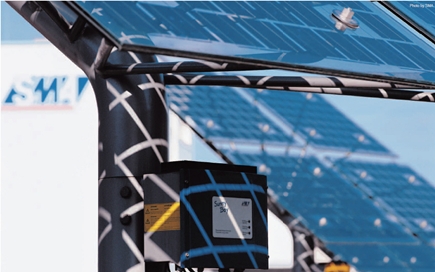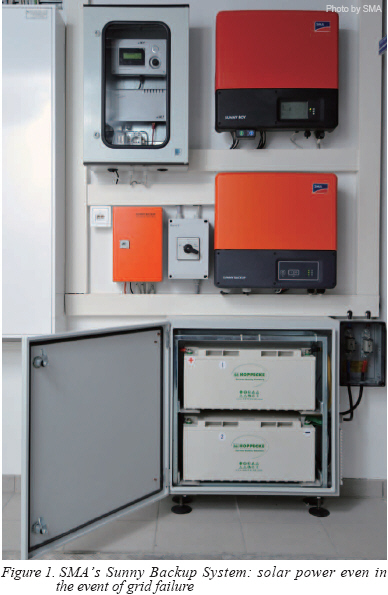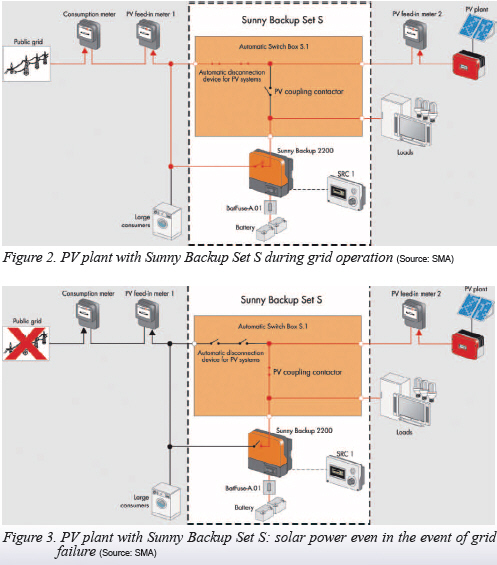By SMA

PV Backup Systems Secure Power Supply and also Maximize Internal Consumption
If a power failure occurs, most PV plant owners are not aware their systems are disconnected from the power grid. Once disconnected PV plants can no longer supply solar power to their homes?regardless of how much sunlight is available.
The German safety standard VDE 126.1.1 requires the immediate disconnection of grid-feeding inverters during a power failure in order to ensure safety for those working on the assumed voltage free grid. Today, you can easily protect yourself against power failures around-the-clock. SMA offers a complete PV plant that is pre-configured, easy to install and allows you to add a battery inverter with a connected storage device.
A Comprehensive Combination
The remarkable feature of this backup system is its ability to withstand a power failure by supplying power from the battery and also the PV plant (if there is enough sunlight). Therefore, you can use smaller batteries saving both space and costs. An additional advantage is that it provides the internal consumption of solar power, a function promoted since 2009. Power storage systems give you the freedom to choose when you want to consume solar power regardless of when it was generated. This allows you to significantly increase the solar power you can use in your home.
 Wide Product Range Wide Product Range
SMA provides backup systems in four different power ranges: the Sunny Backup Sets S, M, L and XL. The S model was specifically developed for lower power ranges and is suitable for small home rooftop systems that generate up to 5 kWp (Figure 1). We use the term ¡®Set¡¯ here literally: A Set is a pre-configured and optimally tuned package that contains all necessary components, including batteries and cabling. For Set S, the maximum inverter battery power used to operate electrical appliances (with battery support) is 2,200 W during continuous operation. In contrast to many other battery inverters, the Sunny Backup 2200 can carry significantly higher loads. It can produce 2,900 W for 30 minutes or as much as 3,800 W for one minute, almost twice the nominal power. Another advantage is the possibility to add a backup system to an existing PV plant at any time (provided SMA PV inverters are used). Plus, the backup system supports the high efficiency of the PV plant.
Four Key Components
A PV plant with the Sunny Backup Set S is composed of four components: the Sunny Backup 2200 battery inverter, the Automatic Switch (AS) Box S, the battery pack and the PV inverter. The battery inverter performs many tasks: it monitors the battery, converts battery electricity into Alternating Current (AC) when required, functions as a grid former, and is responsible for voltage, frequency and phase shift, if the public power grid fails. All AC cables converge in the Automatic Switch Box S. The relay that transports the PV power to the house grid when a disconnection device is triggered is also located here.
The battery serves as an energy source if a grid failure occurs and the current amount of PV power is insufficient. In terms of capacity, the battery is designed to power the most important electrical appliances at night or when PV power is low.
Finally, it is essential that the PV inverter is integrated into the backup system. When its grid monitoring function is switched to ¡®Off-Grid¡¯ mode, it has a higher tolerance for deviations in grid parameters to accommodate the more sensitive control behavior of stand-alone grids. In addition, it is able to reduce its feed-in power depending on the frequency of the stand-alone grid. This feature prevents excess power, specifically, when the energy required in the home is less than the PV array supply, when the battery is fully charged.
Fail-Safe Power Supply

In Figure 2, PV plants are equipped with a backup system and a meter configuration for measuring internal consumption, a feature available since 2009. The generation meter is located directly behind the PV inverter while a reference and a feed-in meter are placed one after the other on the cable leading to the public grid (both are usually combined as a bidirectional meter). Typically PV power flows through the AS Box to the electrical household appliances. Only the power that is not consumed immediately will flow to the grid via the feed-in meter. Conversely, if the consumption load exceeds the amount of PV power, the difference is taken from the grid.
If a grid failure occurs, the switch box (AS) disconnects from the grid within 50 milliseconds and at the same time the appropriate battery inverter relay opens and the PV coupling relay closes (Figure 3). This ensures electrical household appliances continue to receive power from either the PV plant, the battery, or both depending on the power available. If required, the Sunny Backup 2200 feeds in the energy to the three phases of the house grid. In the grid former function, the battery inverter keeps the supply and demand of power in balance (Note: the maximum generating capacity is determined by the sum of the current PV power and the maximum battery inverter power).
PV power consumed at home is still measured by the difference in meter readings and calculated accordingly: When the feed-in meter is idle, internal consumption equals PV generation, regardless of whether an electrical appliance is being used or the battery is recharging.
Higher Internal Consumption through Load Shift
In addition to the backup function, PV plants equipped with power storage also offer a way to increase the internal consumption rate through load shifting. Internal consumption (as defined in Section 33 of the German Renewable Energy Sources Act [EEG]) refers to the amount of PV energy consumed where it is generated. Therefore, the internal consumption rate equals the portion of the total PV energy generated that is used for internal consumption.
The attainable rate of internal consumption is largely determined by two factors: the ratio of generation and consumption and their correlation over time. Here are two examples: Assuming an annual production of 40,000 kWh and a typical household demand of 4,000 kWh, the internal consumption rate can never exceed 10% regardless of the correlation. However, if generation and consumption are equal yet occur at completely different times, the internal consumption rate remains zero.

Generated PV power that is not consumed directly can be stored in the battery instead?this is precisely when a battery system is the most useful. You can easily use the stored PV power anytime you choose.
According to SMA analysis, in a four-person household with a 5 kWh peak power PV plant, the ¡®natural¡¯ internal consumption rate averages around 30% annually. With a Backup Set S, the average can be increased to 55%.
Complex Task: Energy Management
For the maximum power storage all meter readings need to be recorded and analyzed quickly, which in turn requires ¡®smart¡¯ power meters to output data. This data can be used to determine the current values for generation, consumption, internal consumption and grid feed-in. Based on the results, the system analyzes and chooses one of the following: Whether it is better to store excess solar power in the battery or feed it into the grid; or if the PV power is low, whether the power required for electrical appliances should be taken from the battery or from the grid. It is also possible to use battery and grid power interchangeably. These decisions can be made based not only on the charge status of the battery, but also based on time-variable electricity tariffs or forecast data for PV generation.
Upcoming Product Solutions
For the beginning of 2012, SMA announced a product solution for energy management: the Sunny Home Manager, which is also designed to integrate the Sunny Backup System. Its basic function of a fail-safe power supply is already an attractive feature for PV plant owners, especially as the costs for the complete set are only slightly more than 20% of a typical 5 kWp plant. A modified version of the Sunny Backup System will be available in August 2011: by means of an additional meter interface and an extended software, the Sunny Backup System can now independently increase the rate of self-consumption, temporarily storing solar power by decreasing the exchanged power with the grid to zero, whenever possible. With this product, nearly every PV plant owner can access an advanced and future-oriented power supply.
SMA (www.sma.de) is the world¡¯s largest manufacturer of PV inverters.
For more information, please send your e-mails to pved@infothe.com.
¨Ï2011 www.interpv.net All rights reserved. |



